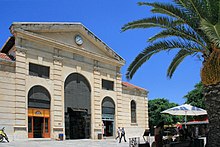Chania Market Hall
The Chania Market Hall (also known as the Municipal Market Hall or Agora ) is a market hall opened in 1913 in Chania , the second largest city in Crete . The classicist building with an area of 4000 square meters is laid out in the shape of a cross and has an entrance at each end of the cross arms.
history
The city has flourished since the time of Cretan independence from 1898. After the annexation to Greece, Chania was the capital of Crete and an important trading center with 20,000 inhabitants. The shops were scattered across the city. While the butchers were located outside the city, the fruit and vegetable dealers sold their goods on the streets of the city. The fish market took place in the harbor. To bring this together, the cross-shaped classical market hall (agora) was built between 1911 and 1913. It was based on the French model of the market hall in Marseille and became one of Chania's landmarks. Parts of the city moat and the old Piatta Forma bastion were chosen as the location. The Venetian city gate Porta-Retimiota fell victim to the construction of the hall.
construction
In July 1908 the city council decided to build a market hall. The first drafts were already ready in August 1908. In February 1909 the plans were completed by the engineers Konstantinos Drandakis and Michael Savvakis. 78 stands and a construction cost of 320,000 drachmas were planned. In December 1910 the Bank of Creta granted a loan of 300,000 drachmas. Mathioudakis Anthony won the tender to build the market hall with an offer price of 290,000 drachmas.
The recently newly elected mayor Chania laid the foundation stone for the market hall on August 14, 1911. During the construction there were discussions about the floors to be installed (asphalt, concrete or marble). In addition, the roof was 37 tons heavier and 17,000 drachmas more expensive than planned. A request was made to increase the loan by 200,000 drachmas. But only 85,000 drachmas were allowed.
In the second half of 1913, construction of the hall was almost complete. On November 1st there was an unofficial opening of the market under the name “Neuer Markt”. The rents for the stands were staggered and amounted to, for example, 450 drachmas for butchers, 550 for greengrocers and 1000 drachmas for restaurants. The rents were paid directly to the bank to repay the loans. It was open from sunrise to 10 p.m. Groceries were sold in the middle of the market hall. There was also an urban scale there. The meat trade took place in the arms of the cross. Only a few butchers sold pork, as numerous Muslims from the Ottoman period between 1645 and 1900 lived in Chania. The first hall inspector of the market was Stathis Papadakis. He received a salary of 120 drachmas. All stalls were accessible from the outside of the market.
As part of the celebration of the unification of Crete with Greece in early December 1913, the market hall was inaugurated on December 4, 1913 by the then Prime Minister Eleftherios Venizelos .
today
The Chania market hall has been a listed building since 1980. Inside there are still food stalls and small restaurants. Mainly, goods for tourists such as olive products, tsikoudia and sweets are offered.
Web links
- Presentation of the market hall on www.chaniatourism.com
Individual evidence
- ^ The Municipal Market. www.chaniatourism.com, accessed on November 13, 2015 .
- ^ Municipal Market. (No longer available online.) Www.scanmy.net, archived from the original on November 17, 2015 ; accessed on November 13, 2015 . Info: The archive link was inserted automatically and has not yet been checked. Please check the original and archive link according to the instructions and then remove this notice.
- ↑ Η Δημοτική Αγορά Χανίων. www.chania.gr, accessed November 13, 2015 (Greek).
Coordinates: 35 ° 30 ′ 52.1 ″ N , 24 ° 1 ′ 13 ″ E


